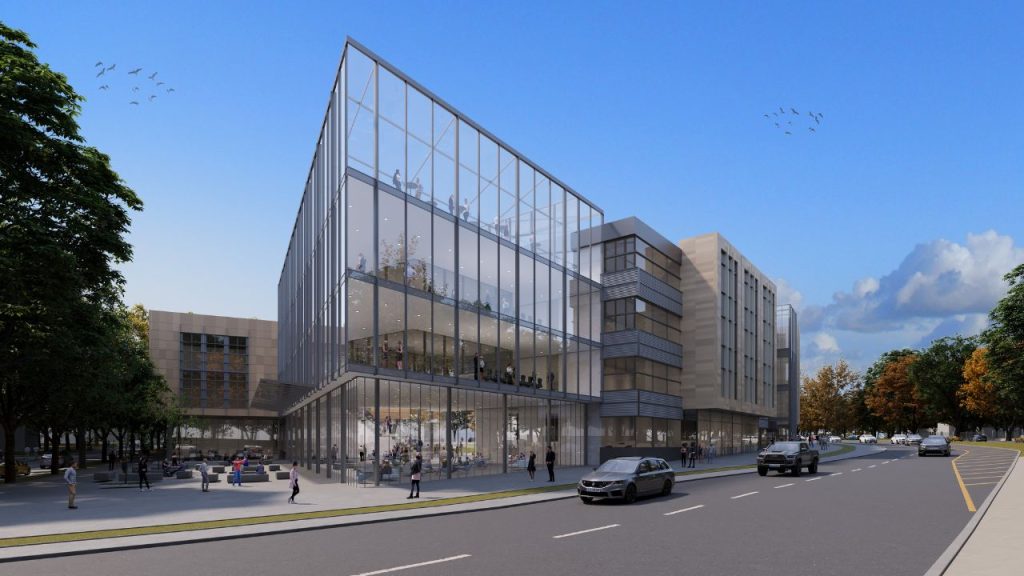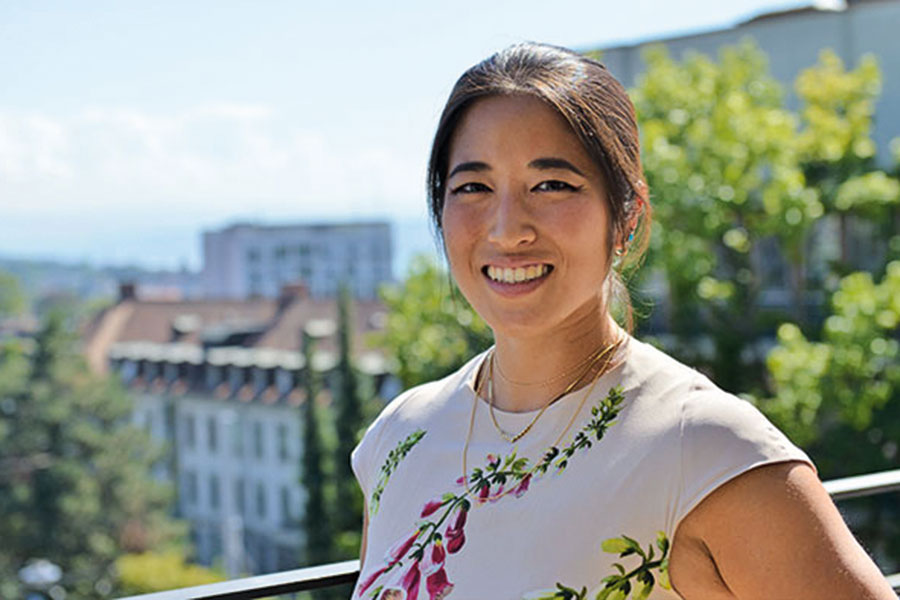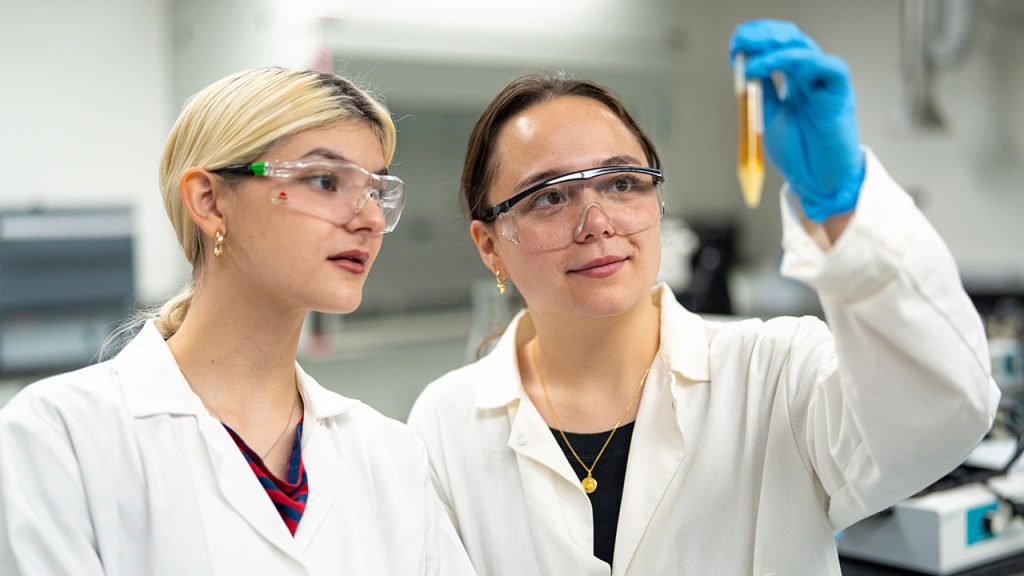College is playing out differently than Alexandra Ren and Liana Cutter imagined. And they’re thrilled about it.
As she prepares to start her senior year at Fordham, Ren is working with Professor Ipsita Banerjee, Ph.D., to design molecules to target the brain proteins that trigger Alzheimer’s disease symptoms. Cutter, who will be a junior this fall, is collaborating with Banerjee to develop peptides aimed at the cell receptors involved in cancer metastasis. Both have co-written articles for scientific journals and presented their work at conferences, gaining experience in endeavors that—along with their research—are generally the purview of grad students.
“One of the things I really encourage my students to do is to think about college as an investment in themselves,” says Banerjee, a nanobiotechnology researcher whose lab offers opportunities to about 15 undergraduates a year. “The time that you’re putting into research, into learning, into the skills that you’re developing is really an investment that you’re making in yourself.”
Ren and Cutter got their mentor’s message, and as they deepen their personal investments with long hours in and out of the lab, the University community is making a huge investment in their field and other STEM disciplines.
In March, Fordham announced a $100 million gift from Maurice “Mo” Cunniffe, FCRH ’54, and Carolyn Dursi Cunniffe, Ph.D., GSAS ’71, that will be used to break ground on a state-of-the-art integrated science center on the Rose Hill campus and to launch and expand in-demand programs in science, technology, engineering, and math. Earlier gifts from Fordham trustee Kim Bepler and her late husband, Steve Bepler, FCRH ’64, created a vision for the new center and established five endowed chairs in STEM fields, enabling Fordham to attract exceptional faculty.

‘Tune In to What You’re Passionate About’
Ren and Cutter are among the pioneers in the University’s growing emphasis on the sciences: The biochemistry major they’re pursuing wasn’t an option until fall 2023, when both declared it right after connecting with Banerjee.
“I came from Costa Rica, a very rural part, and I had never been in a lab before,” Cutter says. “It has really opened my eyes. In Costa Rica, if you like science, you become a doctor. Coming to school here, I see all these possibilities that involve science and the medical field. Right now I’m considering doing an M.D./Ph.D. program because I really do love the clinical aspect, but I have fallen in love with research, and I don’t think I could ever live without it.”
In Ren, Banerjee found another aspiring scientist willing to put in the work. The daughter of two chemists, the Pennsylvania native had spent a year as an economics major when a chance meeting with Banerjee, who directs the biochem program, made her realize how much she missed science.
Ren is on a chemistry-focused track of the interdisciplinary program, “but with classes that provide a better background in biology, which I enjoy.”
She sees that foundational combination as beneficial for the research career in academia or industry that she plans to pursue after grad school. Her current research focus is inspired by a family history of Alzheimer’s, she says, adding that in Banerjee’s lab, “you’re really able to tune in to what you’re passionate about.”

Boosting Fordham’s Appeal to College-Bound Students
The new biochem major is among many developments aimed at strengthening Fordham’s commitment to STEM disciplines, a strategic move that within eight years aims to increase enrollment by as many as 900 undergraduates and 600 graduate students across the Rose Hill, Lincoln Center, and Westchester campuses.
The initiative is also pragmatic: 48% of college-bound U.S. high school students want to pursue STEM majors, and jobs in those fields are projected to grow 40% faster than other jobs over the next decade.
Many universities offer expertise in STEM, but Fordham can claim a unique space by doubling down on its distinctive identity and strengths as the Jesuit university of New York, says President Tania Tetlow.
“For centuries, the Jesuits have been world-class scientists and mathematicians, always connecting those fields to what it means to be fully human,” she observes. “Fordham will stand out for integrating science and technology with ethics, humanities, and our other strengths in the professions.”
RELATED STORY: How to Educate STEM Leaders with Soul and Purpose
The integrated science center at Rose Hill is expected to open in five to seven years, depending in part on the pace of fundraising. The complex will feature wet and dry teaching labs, research space, classrooms, and lounges that encourage mingling among students from different fields of study.

An array of disciplines now housed in separate buildings—biological sciences, chemistry and biochem, computer science, mathematics, and physics—will have a common home. The center’s location, replacing surface parking along the eastern edge of campus, will also create a STEM hub across the street from two other world-class institutions: the New York Botanical Garden and the Bronx Zoo/Wildlife Conservation Society, offering greater visibility to the community and new options to deepen long-standing partnerships.

“The center will allow for a lot more cross-pollination across academic areas and be built with a greater eye toward collaboration,” says Fordham Provost Dennis Jacobs, Ph.D. “We want to be in partnership with entities across industries that will allow us to do better science and hopefully allow them to advance in their own spaces.”
New Graduate Degree Programs Propel Tech Innovation
A trio of new and recent graduate degree programs is preparing students to apply the latest tech to ignite innovation and entrepreneurship in business, computer science, and health care.
M.S. in Artificial Intelligence in Business
The Gabelli School of Business is teaching current and aspiring business professionals to lead the adoption, application, and management of artificial intelligence within their organizations.
“This degree provides an essential toolkit for those who are technically inclined, as well as for those whose responsibilities lie in business efficiency, management, finance, marketing, and so many other areas that will be totally transformed by the use of AI,” says Gabelli School Dean Lerzan Aksoy, Ph.D.
Full- or part-time study is possible, with internship opportunities at some of New York City’s top firms.
Ph.D. in Computer Science
This full-time program, launched in 2022, is educating the next generation of researchers, faculty, and industry leaders in a field of constant innovation. Studying in New York City among thousands of multinational corporations, students team up with practitioners eager to discuss research ideas and wide-ranging industries willing to share corporate data.
The program promotes ethically informed tech research in the public interest while delving into such topics as machine learning, artificial intelligence, robotics, data analytics and informatics, data and information fusion, software engineering, and cybersecurity.
M.S. in Applied Health Informatics
The digital health care revolution is real, and Fordham’s grad program in applied health informatics is helping medical professionals develop the skills they need to take part in it. Graduates work in a variety of settings, including large hospitals, health care systems, clinics, insurance companies, and public health agencies.
Driven by its Jesuit mission of academic excellence, service in the promotion of justice, and exercising discernment in all things, Fordham teaches students to be responsible stewards of technology and innovation and to use those resources to elevate the quality of life for all.
Educating Tomorrow’s Leaders to Cultivate Healthy Communities
Collaboration is key in many of the new degree programs now taking shape, including several tied to health care. That field is forecast to continue expanding, with more than 2 million jobs opening up each year through 2033, according to Bureau of Labor Statistics estimates.
“Fordham wants to use health care to bind a lot of our STEM work in the next five to 10 years because employment in this space, both in research and in the medical field, is going to grow,” says Falguni Sen, Ph.D., a professor of strategy and statistics recently named special advisor to the provost on health care. “I’m very optimistic about our expansion in STEM. It brings colleagues together to work on common problems, and it will have a great impact on the city and state.”
Under the new Fordham Alliance for Better Health that Sen leads, the University has connected three centers and 17 programs that focus on healthy communities, primarily in the areas of well-being, caregiving, aging, and workforce development. The idea is to expand partnerships to give students more opportunities and to encourage transdisciplinary research among faculty.
Sen shares two examples. Fordham is looking to introduce a full-time master’s degree to train physician assistants. The new physician assistant studies program will include vital clinical rotations for students in area hospitals and build on the success of Fordham’s master’s degree in health administration. That program, established in 2018, allows students to work full time while taking courses that help prepare them for leadership roles in the field. Graduates have experienced a 90% employment rate in the degree program’s first seven years in existence, Sen says.
Fordham is also launching a master’s degree program in biotechnology this fall, a program Sen has worked with colleagues across the University to build. It’s a prime example of an in-demand degree that blends Fordham’s strengths in the humanities, law, social science, business, and computer science with traditional science—all disciplines that will be reflected in the biotech curriculum.
“The M.S. in biotechnology will bring many elements together to provide patient-centered solutions,” Sen says. “Fordham is a very unique place that, in a single one-year program, can combine ethics and other aspects of the humanities, great work in the sciences, a business school that focuses on entrepreneurship, a law school that works on compliance and government regulations, and expertise in data analytics and artificial intelligence.”
Explaining how Fordham can draw from so many areas that might operate in silos elsewhere, Sen, who joined the faculty in 1986, says, “It comes down to people, honestly—people and knowledge of what others are doing.”

The Power of Mentorship
That kind of personal connection proved pivotal for Nako Nakatsuka. Sixteen years ago, it was a glimpse at the research of Ipsita Banerjee that ignited a fire still burning in Nakatsuka’s work. The 2012 Fordham grad is now a world-class researcher developing biosensors for human health applications, including ones that could help revolutionize the study and treatment of Alzheimer’s and Parkinson’s disease.
“When Dr. B introduced me to research, she knew how to get me,” Nakatsuka recalls. “I had a torn ligament from running [track and cross country], and she did tissue engineering research. So she said, ‘Imagine if we could take this vial of serum, inject it into your foot, and your cartilage just regenerates. And you never have to have surgery.’ I was like, ‘That sounds crazy, but wow, that’s super cool.’ And so I really dove into it.”

Like Banerjee protégés Ren and Cutter a decade and a half behind her, Nakatsuka was hooked. In addition to helping her professor study tissue engineering, she conducted research on cell-penetrating peptides for drug delivery applications—but not at Fordham, which didn’t have labs or equipment sufficient for the research. Banerjee arranged lab time for herself and her students at Queens College, more than an hour’s subway ride away, says Nakatsuka, now an assistant professor at the Swiss Federal Institute of Technology.
Banerjee’s mentorship and the grit Nakatsuka discovered in herself led her to national conferences and lead-author science papers as an undergrad. Those accomplishments, in turn, set her up to earn master’s and doctoral degrees in chemistry at UCLA. MIT Technology Review named her to its list of “35 Innovators Under 35” in 2021, and last year, Chemical & Engineering News counted her among its “Talented 12” young scientists improving the world through chemistry.
Nakatsuka is intrigued by Fordham’s plan to expand STEM facilities and programs while attracting more world-class faculty like the mentor who inspired her as an undergraduate.
“Dr. B changed my life,” she says. “Now she’s building a whole biochemistry program for the University. I think it really takes someone with a lot of resilience and guts to do that.”
True—and also someone with the foresight to pass those qualities on to people who will keep them moving forward.
—Mary Alice Casey
Illustrations by David S. Goodsell, RCSB Protein Data Bank and the Scripps Research Institute (from top): details from Kinetochore, Immunological Synapse, and Biosites: Muscle.

